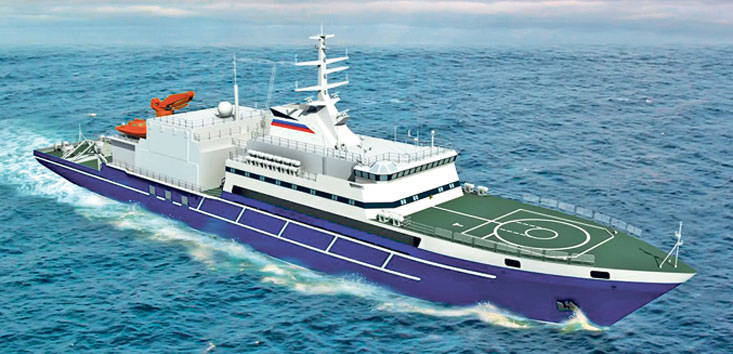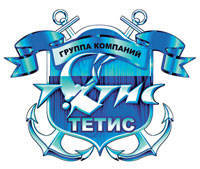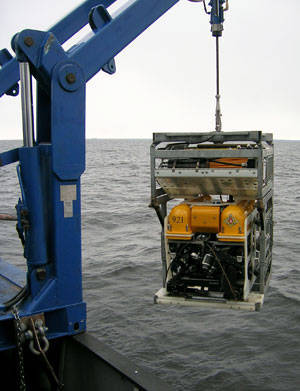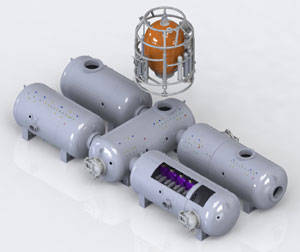"Igor Belousov" will come to the rescue
In recent years, the work on the technical re-equipment of the Navy search and rescue service has increased significantly. The basis of the MSS are oceanic specialized rescue ships of an unlimited navigation area. In the 2012 year, after almost half a century of interruption in the construction of rescue ships, the ship of the 21300 project “Igor Belousov” was launched.
The purpose of the new ship is to rescue and assist crews of emergency submarines at the extreme depths of their voyages, using rescue submarines in conjunction with the decompression complex based on the ship, as well as diving operations at a depth of 450 meters.
"Igor Belousov" is equipped with a complex of search and rescue technical means, which includes towed search equipment based on the latest side-scan sonar, a complex of working deep-sea uninhabited underwater vehicle -Robot with a special multifunctional manipulator device for performing a wide range of underwater technical work, a manned rescue vehicle and a deep-sea diving complex.
Launching such a super-modern rescuer is undoubtedly an important event not only for the Navy’s search and rescue service, but also for the domestic shipbuilding industry.
Why build such ships
In 2011 – 2020, in accordance with the State Armaments Program for 2011 – 2020, a large-scale complex of measures is planned, the implementation of which is aimed at ensuring re-equipment of the Armed Forces of the Russian Federation as part of the formation of their new look.

In accordance with the Military Doctrine of Russia, the submarine fleet remains the basis of our country's marine power, and it will also retain this role in the future. So consider not only experts, but also high-ranking representatives of the military department.
The active construction of submarines implies the development of a naval search and rescue system (JIP), including the rescue of submariners from sunken submarines. In this regard, the commissioning of new rescue vessels equipped with submarine search and rescue submariners is of particular importance today.
According to the classical scheme, when organizing rescue operations, it is necessary to solve three successive tasks: to find and inspect the emergency submarine, remove the crew from it by rescue submersibles and perform underwater technical works using uninhabited submersibles, normobaric space suits to prepare for a ship-raising operation or disposal or preservation sunken submarine.
These tasks, among others, will be solved by the rescue ship of the 21300 project “Igor Belousov”.
History issue
The need to create an ocean rescue vessel, including a rescue submarine, became apparent to the leadership of the Navy fleet back in the first post-war years. The efforts of the Navy and the shipbuilding industry have led to the emergence in the fleet of rescue vessels carrying aboard deep-sea diving complexes (GVK). These were Project 527 vessels (one Epron vessel remained in service as part of the Black Sea Fleet), which allowed organizing the work of divers to a depth of 200 meters, and Project 537 vessels (one Alagez vessel remained in service as part of the Pacific Fleet), which provided launching divers to a depth of 250 meters.
 The stagnation that began in the 70s led to a growing lag in the technical base of the search and rescue service from similar leading foreign structures. You can find many reasons for this - both objective and subjective, but the fact remains that was confirmed by the disaster of the Kursk nuclear missile system. The hundred-meter depth, where the boat was located, which in 70's was not a problem at all for our divers, in 2000 was insurmountable to us. Having mastered the diving descents to 80 meters under laboratory conditions in the 500's, the Navy experts could not put it into practice for objective reasons: in Russia there were simply no vessels capable of ensuring a person’s descent to a depth of half a kilometer in real sea conditions . The shipbuilding industry 70 – 90-ies did not create a deep-sea diving complex at the level that is modern for those years.
The stagnation that began in the 70s led to a growing lag in the technical base of the search and rescue service from similar leading foreign structures. You can find many reasons for this - both objective and subjective, but the fact remains that was confirmed by the disaster of the Kursk nuclear missile system. The hundred-meter depth, where the boat was located, which in 70's was not a problem at all for our divers, in 2000 was insurmountable to us. Having mastered the diving descents to 80 meters under laboratory conditions in the 500's, the Navy experts could not put it into practice for objective reasons: in Russia there were simply no vessels capable of ensuring a person’s descent to a depth of half a kilometer in real sea conditions . The shipbuilding industry 70 – 90-ies did not create a deep-sea diving complex at the level that is modern for those years.We repeat once again that the disaster of the Kursk APRK in 2000 showed clearly the inability of Russia to conduct any serious diving work outside the air depth range, that is, deeper than 60 meters, where divers cannot breathe air. Today, Russia simply needs to be able to and be able to conduct diving work at depths of hundreds of meters, that is, those that withstand the hulls of submarines. Where, in case of impossibility of ascent of a submarine for one reason or another, the hull still retains its strength and tightness, there may be living crew members.
Therefore, the construction of a specialized fleet of rescue vessels, the preparation of deep-sea divers, and the development of a regulatory framework for diving operations at depths of 450 and more than meters are today the most important tasks.
Deep-sea diving complex
GVK "Igor Belousov" is located on five decks in the very middle of the vessel and occupies more than 20 percent of the hull volume. With a little stretch we can say that the ship itself is built around a deep-sea diving complex.
 It is based on five pressure chambers (divided into eight compartments), each with a diameter of 2,3 meter and a length from 4,5 to 5,5 meter (depending on its purpose) and having a working pressure of 45 atmospheres. Different internal equipment is installed in the pressure chambers and, accordingly, they are divided into residential, sanitary facilities and reception and output.
It is based on five pressure chambers (divided into eight compartments), each with a diameter of 2,3 meter and a length from 4,5 to 5,5 meter (depending on its purpose) and having a working pressure of 45 atmospheres. Different internal equipment is installed in the pressure chambers and, accordingly, they are divided into residential, sanitary facilities and reception and output.Residential pressure chambers are equipped with beds, tables, chairs, lockers for storing personal belongings of divers, bedside lamps, headphones for listening to music and other items necessary for organizing the normal life of the crew. In the sanitary compartments there is a toilet and showers - after all, in the cell divers should spend two to three weeks. In the receiving-output compartment, divers put on equipment before the dive and get naked after the dive, through this section they get into the diving bell to dive on the object.
The vital environment in the pressure chambers is created and maintained by special life support systems: they measure the composition and parameters of the gaseous medium in the compartments, replenish it with oxygen, remove carbon dioxide, odors and other harmful gaseous impurities, regulate the temperature and humidity of the respiratory mixture, etc. The life support system includes special devices for cleaning the gas environment in the compartments, gas analyzers, temperature and humidity sensors, pumps, compressors, refrigerating machines and a host of other mechanisms and devices.
The pressure in the chambers rises to the worker by supplying compressed gases from cylinders located right there on board the vessel, and when the pressure is reduced, a special system separates expensive helium from other gases in the atmosphere and pumps it back into the cylinders for reuse.
To the place of work divers are delivered in a diving bell - a small pressure chamber capable of placing inside two working divers in full gear and a diver - the bell operator. The bell tightly fits in with the receiving-output compartment and provides divers with a transition into the bell and back into the compartment without pressure change due to special hatches in the bell and in the receiving-output compartment.
The descent of the bell under the water and its rise to the surface is made by the lifting device (SPU). SPU is a complex technical system that not only lowers and raises the diving bell, but also neutralizes the effects of the ship’s pitching on it, and ensures the safety of the diver in emergency situations.
GVK work is managed around the clock in three shifts. These are operators of panels, compressors, refrigerators, doctors-special physiologists. The descent of divers under the water is led by a special team led by a diving specialist. All information about the physical and psychological state of divers, about the conditions of people in the pressure chambers and under water, the composition and parameters of the breathing mix, the condition and operation of the mechanisms and systems of the complex is collected and processed by a powerful electronic computer as part of an integrated GVK control panel.
A total of 21 people are supposed to be involved in servicing GVK.
The described technology of diving descents is called “Method of long stay under pressure” and is used at depths of more than one hundred meters, although there are exceptions - it all depends on the amount of work to be done. Actually today divers can be under pressure continuously for two to three weeks, followed by the so-called decompression, that is, slow, for many days the pressure drops to atmospheric, after which the divers leave the pressure chambers "to freedom."
This principle was laid down in the basis of the GVK of the rescue vessel “Igor Belousov”.
Survival problems
Two main types of problems needed to be solved in order to ensure that a person stays for many hours under pressure in dozens of atmospheres - medical, physiological and technical.
 Medico-physiological problems consist in choosing the order of pressure rise to the required level and schedule for its reduction, that is, lifting speed and pressure reduction, changing the composition of the artificial gas mixture for breathing (at this depth the air is no longer suitable), work and rest, nutrition, parameters of the microclimate (temperature and humidity) of the environment of residence and the solution of several dozens of other issues that under normal conditions do not even arise, since they were implemented in the course of a century-old evolution that adapted the organism Lovek livelihood at the bottom of the ocean air of the planet Earth.
Medico-physiological problems consist in choosing the order of pressure rise to the required level and schedule for its reduction, that is, lifting speed and pressure reduction, changing the composition of the artificial gas mixture for breathing (at this depth the air is no longer suitable), work and rest, nutrition, parameters of the microclimate (temperature and humidity) of the environment of residence and the solution of several dozens of other issues that under normal conditions do not even arise, since they were implemented in the course of a century-old evolution that adapted the organism Lovek livelihood at the bottom of the ocean air of the planet Earth.Technical problems are to ensure in real conditions with the necessary accuracy all the vital parameters of the gas environment in which the diver is located from the moment of closing the pressure chamber hatch and until its opening.
A separate and at least equally difficult task is to ensure the work of the diver directly in the water, on the object. And here again there are several problems. The main thing is to preserve the life and health of a person staying at the 450-meter depth under the pressure of 45 atmospheres in cold water in complete darkness.
It should be particularly noted that everything described above should be performed with absolute technical reliability. A person under pressure in dozens of atmospheres cannot simply get out of the water or from the pressure chamber — for every 10 meters of depth, in the most general case, he needs one hour of decompression — a long stop to equalize pressure. The body of a person under the pressure of a gaseous medium is like a bottle of champagne. A sharp decrease in pressure — and for champagne this opening of a stopper — leads to foaming of the gases of the respiratory mixture dissolved in the tissues of the body and in the blood and, as a result, to serious illness and even death of a person. Diving practice, as well as high-altitude and space flights of man, knows many similar cases. The process of decompression - reducing pressure - is in itself slow and unavoidable: from the depth of 450 meters the diver must be “lifted” to the surface for more than four days, and whatever happens around - these four days cannot be reduced, otherwise the person will die. We can safely say that an astronaut from orbit can be delivered to Earth several times faster than lifting a deep-sea diver to the earth's surface.
The question is often asked: why put the health and even human life at risk by placing it in the inhuman conditions of a deep-sea diving descent, when modern underwater robots can solve all the tasks at the facility? Unfortunately, this is not the case. The robot, whatever it is perfect, like any machine, even equipped with artificial intelligence, has limited capabilities, while any operation under water, especially rescue, can always present unexpected problems and require for their permission actions beyond machine capabilities that require fast non-standard solutions. Yes, of course, the main part of the work at the facility should be performed by underwater robots, but divers are also required to be on board the rescue ship, because such a situation may arise that the lives of dozens of emergency crew members who fell into the trap may depend on their experience, professionalism and hands. submarine.
But the task of providing deep-sea diving operations tasks of the complex are not limited. The vessel provides for the presence of a manned rescue device for lifting submariners. For this purpose, the pressure chambers of the complex have two docking sites: one for the aforementioned diving bell, and the second for docking with the rescue device located in a special boathouse on board the ship. This unit has a special compartment, the exit hatch of which will firmly and tightly dock with both the special hatch of the submarine’s shelter compartment and the pressure chamber on board the ship. When using a rescue vehicle, the crew of the submarine after docking goes into the compartment of the device and closes the hatch behind him. After undocking, it floats to the surface and comes up to the board of “Igor Belousov”, where the device picks up the launching device, lifts it out of the water, enters the boathouse and lowers the pressure chamber to the coaming site. After docking in the compartments of the apparatus and the pressure chamber, the pressure levels off, the hatches open and the rescued crew members of the boat pass into the ship’s pressure chamber into the hands of the doctors.
For one flight, the rescue device is able to deliver 20 people to the surface, and the compartments of the GVK pressure chambers can receive and provide everything necessary at the same time to the 60 people rescued.
The role of Tethys Pro OJSC
29 in May 2012, the construction plant of the rescue vessel “Igor Belousov” - JSC “Admiralty Shipyards” concluded a contract with JSC “Tethys Pro” for the supply of GVK-450.
The manufacturer of the main elements of the complex on the basis of the analysis of global manufacturers GVK selected company Divex (UK).
To date, in order to organize the construction of the vessel at the Admiralty Shipyards, the company Tethis Pro has already supplied the main equipment for the life of divers. In June, factory tests were completed and the acceptance of pressure chambers and other pressure vessels, tripping devices and other main equipment GVK, which is subject to acceptance by the customer, began. The customer’s supervisory authorities are involved in the factory testing and acceptance of equipment: military acceptance and state technical supervision of the Ministry of Defense of the Russian Federation.
For the operational management of the contract, Tetis Pro OJSC established its engineering and design team in St. Petersburg, working in conjunction with the ship’s designer’s specialists, the Almaz Central Manufacturing Company’s OJSC and the ship builder’s Admiralty Shipyards OJSC, and ensuring prompt resolution of issues arising in work process. The contractor for the supply of GVK - JSC "Tetis Pro" coordinates the activities of equipment manufacturers, its representatives, not limited to information letters, regularly visit manufacturing plants and personally monitor the implementation of agreements. Due to the clear organization of work, the fulfillment of the contract for the supply of GVK is proceeding according to the schedule agreed with the customer.
In addition to the actual supply of equipment, Tetis Pro OJSC, according to the contract, performs installation supervision of the complex and handing over the final mounted and operating GVK-450 aboard the Igor Belousov to the customer.
The obligations of Tethis Pro OJSC are not limited to the delivery of a deep-sea diving complex to the vessel “Igor Belousov”. The scope of equipment supplied by our company includes a towed search complex with a working depth of 2000 meters, which includes a side-scan sonar and a magnetometer, a working unmanned underwater vehicle with a depth of up to 1000 meters, a deep-sea diving equipment, a special tooling and a deep-water tool for working divers the object.
The search complex consists of an underwater towed unit (carrying a side-scan sonar, a magnetometer and other search equipment), a ship's specialized equipment for processing and displaying the collected information, as well as a connecting and towing cable with a special winch. The towed complex performs a search — it “scans” the bottom surface when the carrier vessel is moving and can detect an emergency submarine in the search bar of more than 1000 meters.
The detected submarine or other object at the bottom is examined by the uninhabited submersible Panther Plus or the normobaric “HS-1200” spacesuits. Uninhabited underwater vehicle and normobaric spacesuits are equipped with highly sensitive sonar and television equipment, working manipulators, which allow not only to identify the found object and assess its condition, but also to carry out the necessary preparation of the object for further work of the inhabited rescue device or divers. And at the very final stage of the rescue operation divers enter into action.
Thus, the set of equipment supplied by Tetis Pro OJSC turns the vessel “Igor Belousov” into a rescue vessel, which fully meets the modern level of development of underwater technologies.
Company features
 It should be noted that the supply of search equipment and underwater robots for the Navy is not a new task for Tethys Pro OJSC: more than a dozen of such equipment complexes have been supplied by our company to the fleet, a number of ministries and commercial organizations of Russia, and from year to year the level of demand for equipment is steadily growing.
It should be noted that the supply of search equipment and underwater robots for the Navy is not a new task for Tethys Pro OJSC: more than a dozen of such equipment complexes have been supplied by our company to the fleet, a number of ministries and commercial organizations of Russia, and from year to year the level of demand for equipment is steadily growing.For many years, Tetis Pro OJSC has been producing and supplying Russian state search and rescue services and commercial firms performing underwater work, mobile and stationary shipboard diving complexes with a working depth of up to 100 and more meters, diving equipment and special equipment. .
The Igor Belousov GVK with a working depth of 450 meters, of course, is an immeasurably more complex project, but nevertheless the engineering and technical potential and experience of the Tethys Pro JSC team will undoubtedly allow to solve the task at a high technical level and as scheduled.
Now we can confidently say that “Igor Belousov” will be successfully handed over to the customer and its commissioning will be a turning point in bringing the MSS of the Navy to a level that meets the realities of today. Creating a modern GVK and introducing it into the practice of the search and rescue service will make it possible to take the first step forward not only in rescuing emergency submarine crews, but also in solving the tasks of deep-sea diving work arising in the practice of the Navy.
Help
Alexey Kaifajyan in 1988, he graduated from the Higher Naval School of the Order of the Red Star. A. S. Popova, served as an officer in the compound of large nuclear submarines of the Northern Fleet. Since 1994, he served in the 40-i State Research Institute of Rescue and Deep-Water Works of the Ministry of Defense of the Russian Federation. In the capacity of the head of the laboratory of this research institute, he worked on the creation of search and survey and rescue equipment. Repeatedly participated in the exercises and the actual work of the search and rescue forces of various fleets, expeditions to survey and prepare for the recovery of the sunken AISS "Kursk", as well as in the work of the state commission to investigate the causes of its disaster. Currently - General Director of OJSC Tetis Pro.
Information